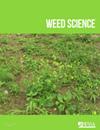模拟温度对入侵杂草银叶夜来香(Solanum elaeagnifolium)根茎萌发的影响
IF 2.1
2区 农林科学
Q2 AGRONOMY
引用次数: 0
摘要
银叶夜来香(Solanum elaeagnifolium Cav.)是一种多年生有害、高入侵性杂草,对夏季灌溉作物、蔬菜和果园构成严重威胁。这种杂草既能通过种子生产进行有性繁殖,也能通过广泛的地下根茎网络进行无性繁殖,后者在杂草的入侵、建立和持久性方面发挥着重要作用。因此,我们的目标是评估温度对不同长度的根茎萌发的影响,并建立萌发动态模型。温度对根茎碎片(2.5、5、7.5 或 10 厘米长)萌芽的影响在生长室中进行了研究,温度范围为 10-45 C。在完全黑暗的 15 C 温度下,所有长度的根茎碎片的萌芽时间都最长。将萌芽率作为温度的函数进行建模,得出了四种不同根状茎片段长度的主要温度值:根茎长度为 2.5、5、7.5 和 10 厘米时,T b(基础温度)分别为 12.80、9.34、9.14 和 9.50 摄氏度;T o(最佳温度)分别为 38.90、36.60、35.16 和 34.86 摄氏度;Tc(最高温度)分别为 39.80、40.08、40.50 和 40.80 摄氏度。根据这些研究结果,讨论了榆叶梅向新地区扩散的潜力和可能的新管理策略;这些都为控制这种杂草提供了一种新的知情决策方法。本文章由计算机程序翻译,如有差异,请以英文原文为准。
Modelling The Effect of Temperature on Rhizome sprouting in the Invasive Weed Silverleaf Nightshade (Solanum elaeagnifolium)
Silverleaf nightshade (Solanum elaeagnifolium Cav.), a noxious, highly invasive perennial weed, poses a significant threat to irrigated summer crops, vegetables, and orchards. This weed has the ability to reproduce both sexually, through seed production, and asexually, via an extensive underground rhizome network, the latter being major role in the weed’s invasion, establishment, and persistence. Our aims were thus to assess the impact of temperature on rhizome sprouting for fragments of different lengths and to model the sprouting dynamics. The influence of temperature on the sprouting of rhizome fragments (2.5, 5, 7.5, or 10 cm long) was investigated in growth chambers at eight temperatures ranging from 10–45 C. The highest sprouting proportions for 10-cm rhizome fragments were recorded at 30 and 35 C in complete darkness. The highest sprouting time for all fragment lengths was observed at 15 C in complete darkness. Modeling sprouting rates as a function of temperature gave the cardinal temperatures for the four different rhizome fragment lengths, with values of: T
b
(base temperature) 12.80, 9.34, 9.14 and 9.50 C, T
o
(optimal temperature) 38.90, 36.60, 35.16 and 34.86 C, Tc (ceiling temperature) 39.80, 40.08, 40.50 and 40.80 C for the rhizome length of 2.5, 5, 7.5 and 10 cm respectively. Based on these findings, the potential for S. elaeagnifolium to spread to new areas and possible new management strategies are discussed; these offer a novel approach for informed decision making regarding the control of this weed.
求助全文
通过发布文献求助,成功后即可免费获取论文全文。
去求助
来源期刊

Weed Science
农林科学-农艺学
CiteScore
4.60
自引率
12.00%
发文量
64
审稿时长
12-24 weeks
期刊介绍:
Weed Science publishes original research and scholarship in the form of peer-reviewed articles focused on fundamental research directly related to all aspects of weed science in agricultural systems. Topics for Weed Science include:
- the biology and ecology of weeds in agricultural, forestry, aquatic, turf, recreational, rights-of-way and other settings, genetics of weeds
- herbicide resistance, chemistry, biochemistry, physiology and molecular action of herbicides and plant growth regulators used to manage undesirable vegetation
- ecology of cropping and other agricultural systems as they relate to weed management
- biological and ecological aspects of weed control tools including biological agents, and herbicide resistant crops
- effect of weed management on soil, air and water.
 求助内容:
求助内容: 应助结果提醒方式:
应助结果提醒方式:


